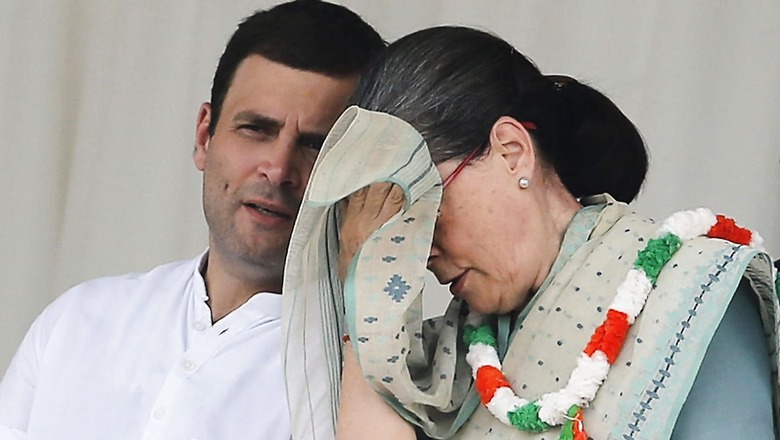
views
During the 2014 Lok Sabha election, Congress and its allies had governments in 13 states, out of which nine states were ruled by a Congress-led government – Karnataka, Haryana, Himachal Pradesh and Uttarakhand and Assam, Arunachal Pradesh, Meghalaya, Manipur and Mizoram in the northeast.
In state-wise alliance governments, Congress was not a junior partner but a leading or equal partner, be in Maharashtra, Kerala, Jammu and Kashmir or Jharkhand.
Cut to August 2022, Congress, on its own, has government in just two states — Chhattisgarh and Rajasthan, and is a junior partner in Bihar and Jharkhand. In Tamil Nadu, it is part of the DMK led alliance that won the last assembly election but is not part of the government. The downfall that began with the 2014 Parliamentary election has continued unabated so far with many senior and junior leaders quitting the party.
REASONS
Congress is facing a survival crisis. The party has restricted itself to the leadership of the Nehru-Gandhi family even if its electoral performance has nosedived election after election. Those who raise any voice for leadership change are either humiliated or suspended or expelled as alleged by the party dissenters. Some prominent leaders from G-23, a group of senior Congress leaders, have quit the party alleging so.
The matter is worsened by the heightened crisis between the old guard of political leaders in the party and the new guard. The party has failed to strike a balance between the two genres resulting in many young and promising leaders, who are now either CMs — Assam’s Himanta Biswa Sarma — or civil aviation minister Jyotiraditya Scindia, quitting and joining the rival camp. Both were promising leaders who joined the BJP alleging their disappointment with the Congress, its management and work culture.
The Congress fundamentally needed to reform itself to go back on the path that it once was, ruling almost the entire country, but it was an aspect totally ignored by the party’s top management. The party needed restructuring of its internal democracy that it failed to address.
The poor state of affairs within the party has reflected its detonating electoral performance.
Historically Low Lok Sabha Numbers
Congress saw its historical low in 2014 where it won only 44 seats from 206 seats it had secured in the 2009 Lok Sabha election. In the 2014 Parliamentary polls, the Congress was virtually wiped out from many states, and failed to bag even the post of the Leader of Opposition in the Lok Sabha. This was the first time when Rahul Gandhi’s leadership was questioned. Being party’s vice-president then, Rahul was Congress’ central figure and worked as a de facto president.
The 2019 Lok Sabha election was no better. The party could win eight more Lok Sabha seats but its vote share remained the same. The party had received 19.5% votes in 2014 while it bagged 52 seats with 19.6% vote share in 2019.
Just 9 Wins in 50 Assembly Elections
The decimation of the party reflects in its performance in the assembly polls.
From 2014 to 2022, India has seen 50 assembly elections and Congress could win just in nine. What should be more worrying for the party is that most of these wins are from smaller states that are electorally insignificant for a party’s pan-country survival.
The party continued its winning run in the Arunachal Pradesh assembly election in 2014 where it won 42 of the 60 seats in the assembly but lost the state in just two years with rival camps within the party pulling the plug.
Arunachal Pradesh’s political crisis began in 2015 with a senior Congress leader and minister revolting and pulling down the government. Though after the Supreme Court’s verdict, the previous Congress government was reinstalled, 41 MLAs of the party’s state unit soon decided first to join a regional party, the People’s Party of Arunachal, and then the BJP on December 31, 2016.
In the 2019 assembly election in the state, the grand old party of India could not even find candidates for all the 60 assembly seats in the state and fought on 46 seats winning only four seats.
Next was Puducherry in 2016, a small Union Territory, but lost the government just before the next election, in February 2021 with five Congress MLAs resigning. The CM lost the trust vote and saw a massive decline in the next election, winning just two out of 30 seats in the assembly.
It won the Bihar assembly election in 2015 but was a junior alliance partner only.
The party’s first big win came in 2017 in the Punjab assembly polls. But the culture of factionalism and internal leadership led to a string of resignations in the party with CM Amarinder Singh, who was behind the 2017 win, quitting. The Congress saw a massive loss in the polls that took place earlier this year winning just 18 of the 117 assembly seats in the state.
In Goa assembly polls in 2017, the Congress was the largest party but fell short of the majority mark. In the 40-member assembly, the party won 17 seats but could not stitch an alliance in time and the BJP with 13 seats formed the government, taking other parties on board. In the 2022 state assembly polls, the Congress failed to make a comeback while the BJP increased its seats from 13 to 20. It retained the Chief Minister’s Office by forming an alliance again while the Congress slipped to 11 seats.
Manipur saw the similar fate. The party that ruled Manipur from 2002 to 2017 was also the largest party in the 2017 assembly polls winning 28 of the 60 seats in the assembly. But like Goa, the party failed to stitch up an alliance before the BJP, which bagged 21 seats. The BJP allied with regional parties to form the government. In the 2022 assembly election in the state, the Congress was almost wiped out with just 5 seats while the BJP retained government winning a majority this time. The party won 32 seats.
The year 2018 was electorally good for Congress. The party won a majority mark in three Hindi heartland states — Rajasthan, Madhya Pradesh and Chhattisgarh — but its internal leadership tussle ultimately proved an image disaster.
Chhattisgarh was a massive Congress victory where it won 68 out of 90 seats in the assembly. The party had leadership tussle between Bhupesh Baghel and TS Singh Deo but the Congress high command preferred to go with Baghel to appeal to the OBC voters of the state. With numbers on its side, the government have survived well so far.
In Rajasthan, it won 100 out of 200 seats in the assembly. The ruling BJP government was slipped to second spot with 73 seats. Also, independents were big gainers winning 13 seats while the BSP bagged six seats and CPM two seats. So, in spite of the leadership tussle between Ashok Gehlot and Sachin Pilot, with Pilot being the electoral face of the party in the elections, the Congress government could survive in the state as BJP, with 27 seats less than the Congress mark, had not much to gain on the number’s front.
Madhya Pradesh was a difficult option for the Congress as Jyotiraditya Scindia’s was the party’s electoral face but Kamal Nath was later chosen for the top post. Out of the 230 seats in the assembly, the Congress won 114 seats, two seats short of majority, but just five seats more than the BJP, the party that ruled the state since December 2003. Independent MLAs won 4 seats while the SP won one seat.
Result? The government could survive just for 15 months, from December 2018 to March 2020 after Scindia, miffed with the Congress high command, moved out of the party along with 22 rebel Congress MLAs and joined the BJP later.
The 2018 assembly election in Meghalaya again saw a hung verdict with the ruling Congress emerging as the largest party winning 21 of the 60 seats in the assembly but the big winner was the National People’s Party-led alliance with the BJP and other regional parties. With 34 seats on its side, the alliance formed the government.
The JMM-Congress-RJD alliance won the 2019 Jharkhand assembly elections with Congress as junior partner. JMM won 30 seats in the 81-member assembly while Congress won 16 and RJD one seat.
The year 2020 was blank for the Congress with almost no show in Delhi and Bihar assembly elections.
The DMK-led alliance including Congress and regional parties won the 2021 assembly election in Tamil Nadu. The alliance won 159 seats in 234-member assembly. DMK won 133 seats. The Congress was second largest party in alliance but was far behind from DMK winning just 18 seats.
This year too is going bleak for Congress in terms of electoral victories and setting up of the government. The party has failed miserably in five assembly elections held this year so far — in Uttar Pradesh, Punjab, Goa, Uttarakhand and Manipur. It was a comprehensive political defeat that again raised questions on its leadership.
Read all the Latest Opinion News and Breaking News here



















Comments
0 comment